1994 CADILLAC SEVILLE brake
[x] Cancel search: brakePage 147 of 399
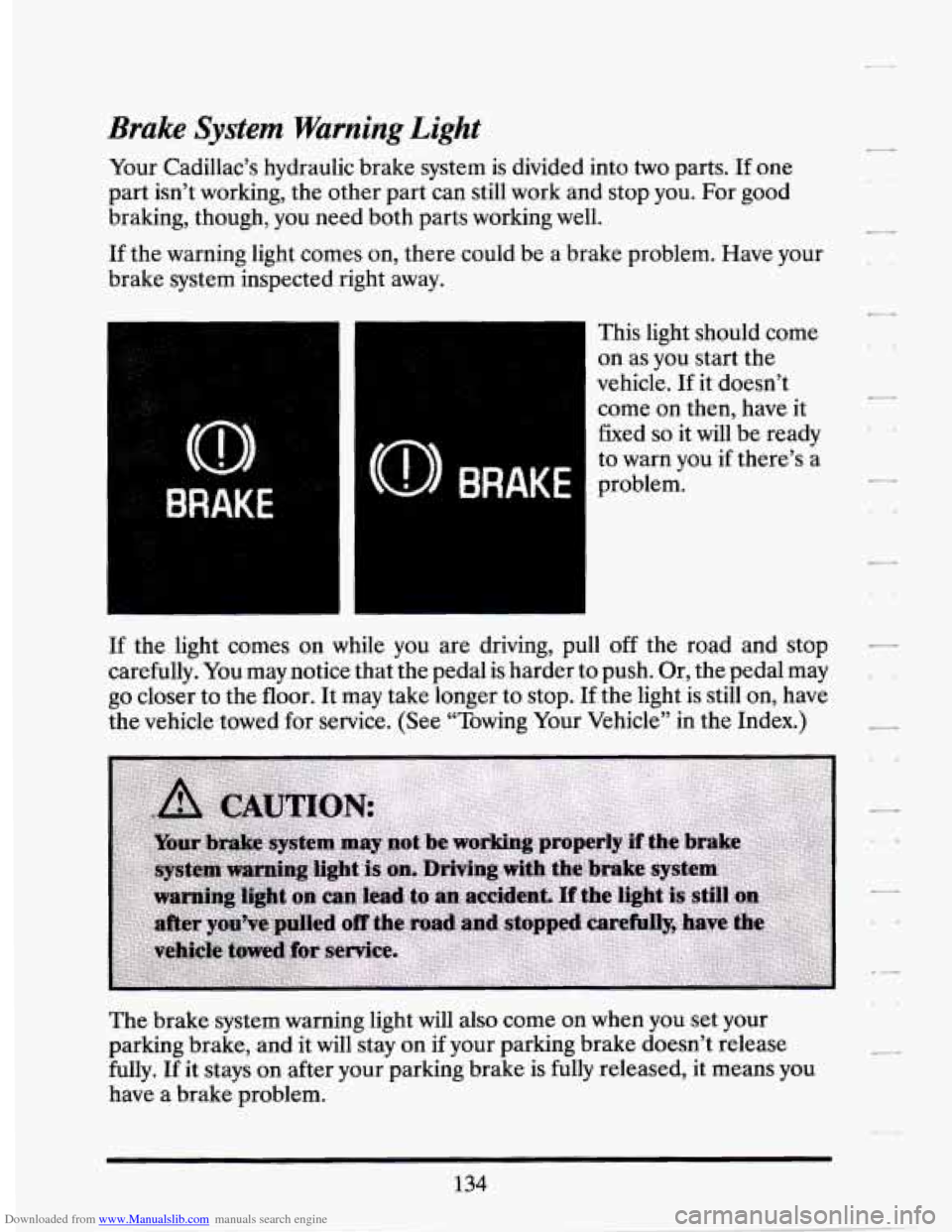
Downloaded from www.Manualslib.com manuals search engine Brake System Warning Light
Your Cadillac’s hydraulic brake system is divided into two parts. If one
part isn’t working, the other part can still work and stop you. For good
braking, though, you need both parts working well.
If the warning light comes
on, there could be a brake problem. Have your
brake system inspected right away.
This light should come
on as you start the
vehicle.
If it doesn’t
come on then, have it
fixed
so it will be ready
to warn you if there’s a
problem.
If the light comes on while you are driving, pull off the road and stop
carefully. You may notice that the pedal is harder
to push. Or, the pedal may
go closer to the floor. It may take longer to stop.
If the light is still on, have
the vehicle.towed for service. (See “Towing Your Vehicle” in the Index.)
The brake system warning light will also come on when you set your
parking brake, and it will stay on
if your parking brake doesn’t release
fully.
If it stays on after your parking brake is fully released, it means you
have a brake problem.
134
5-
LC.
Page 148 of 399

Downloaded from www.Manualslib.com manuals search engine Anti-Lock Brake System Warning Light
II
With anti-lock, this light will come on when you start your engine and
may stay on for several seconds. That’s normal.
If the light doesn’t come
on, have it fixed
so it will be ready to warn you if there is a problem.
If the light stays on, turn the ignition off. Or, if the light comes on when
you’re driving, stop as soon
as possible and turn the ignition off. Then
start the engine again to reset the system. If the light still stays on, or
comes on again while you’re driving, your Cadillac needs service. If the
regular brake system warning light isn’t on, you still have brakes, but you
don’t have anti-lock brakes. If the regular brake system warning light is
also on, you don’t have anti-lock brakes and there’s a problem with your
regular brakes. See “Brake System Warning Light” earlier in this part.
135
Page 157 of 399

Downloaded from www.Manualslib.com manuals search engine Oil Life Left Reset
Press successively the INFORMATION button to display the “OIL LIFE
LEFT”, then press and hold the RESET button until “0.0 OIL LIFE
LEFT” is displayed.
DISPLAY ON/OFF Button
Pressing this button will turn off the Driver Information Center,
Electronic Climate Control and Fuel Data Center displays. If you have
the Digital cluster, the fuel gage, trip and odometer
will also turn off.
While displays are off, pressing the INFORMATION button will turn on
only the Driver Information Center.
If any other button is pressed or a
driving warning message needs to be displayed, or fuel level falls below
4 gallons, all the displays will come back on.
TRIP SET Button
Press and hold this button to set the Trip Odometer back to zero.
ENG/MET (English/Metric Button)
Press this button to switch from English (miles) and Degrees (Fahrenheit),
to Metric (kilometers) and Degrees (Celsius).
Driver Information Center Messages
These messages will appear if there is a problem sensed in one of your
vehicle’s systems. Vehicles that are first sold in Canada or are export
vehicles will have a number after each message. This number helps to
identify that message, which is only displayed in English.
APPLY BRAKE TO SHIFT - 46
This message will appear if your vehicle is in “P” (Park) for about
15 seconds and the brake is not depressed. If you do not want this
message to appear, you can cancel this message by holding the “OFF”
and the Blue (cooler) button on the Electronic Climate Control panel for
about
5 seconds. Hold the same two buttons again to have this message
displayed again.
144
Page 159 of 399
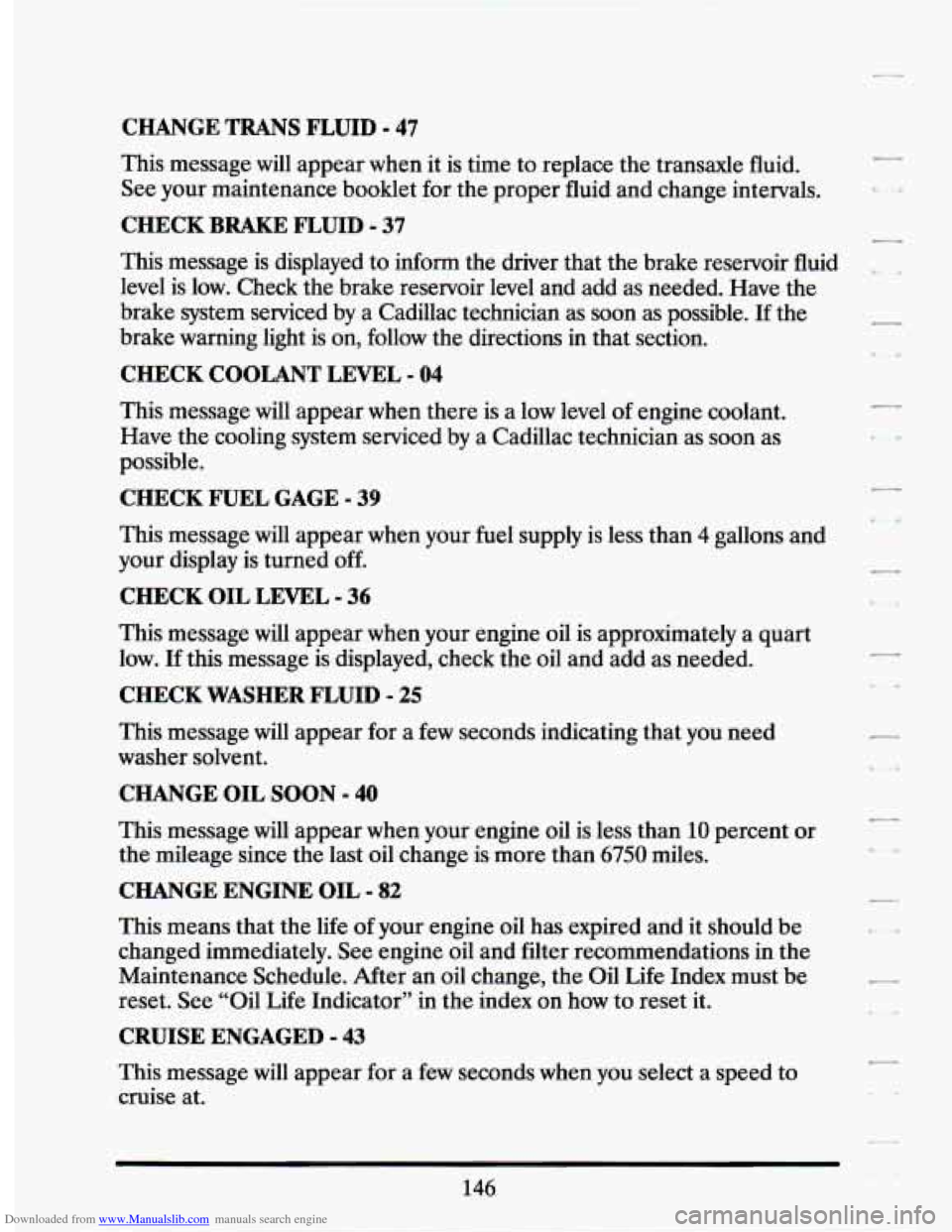
Downloaded from www.Manualslib.com manuals search engine CHANGE TRANS FLUID - 47
This message will appear when it is time to replace the transaxle fluid.
See your maintenance booklet for the proper fluid and change intervals.
CHECK BRAKE FLUID - 37
This message is displayed to inform the driver that the brake reservoir fluid
level is low. Check the brake reservoir level and add as needed. Have the
brake system serviced by a Cadillac technician as soon as possible. If the
brake warning light is on, follow the directions in that section.
CHECK COOLANT LEVEL - 04
This message will appear when there is a low level of engine coolant.
Have the cooling system serviced by a Cadillac technician as soon as
possible.
CHECK FUEL GAGE - 39
This message will appear when your fuel supply is less than 4 gallons and
your display
is turned off.
CHECK OIL LEVEL - 36
This message will appear when your engine oil is approximately a quart
low.
If this message is displayed, check the oil and add as needed.
CHECK WASHER FLUID - 25
This message will appear for a few seconds indicating that you need
washer solvent.
CHANGE OIL SOON - 40
This message will appear when your engine oil is less than 10 percent or
the mileage since the last oil change is more than
6750 miles.
CHANGE ENGINE OIL - 82
This means that the life of your engine oil has expired and it should be
changed immediately. See engine oil and filter recommendations
in the
Maintenance Schedule. After an oil change, the Oil
Life Index must be
reset.
See “Oil Life Indicator” in the index on how to reset it.
CRUISE ENGAGED - 43
This message will appear for a few seconds when you select a speed to
cruise at.
146
7
Page 187 of 399
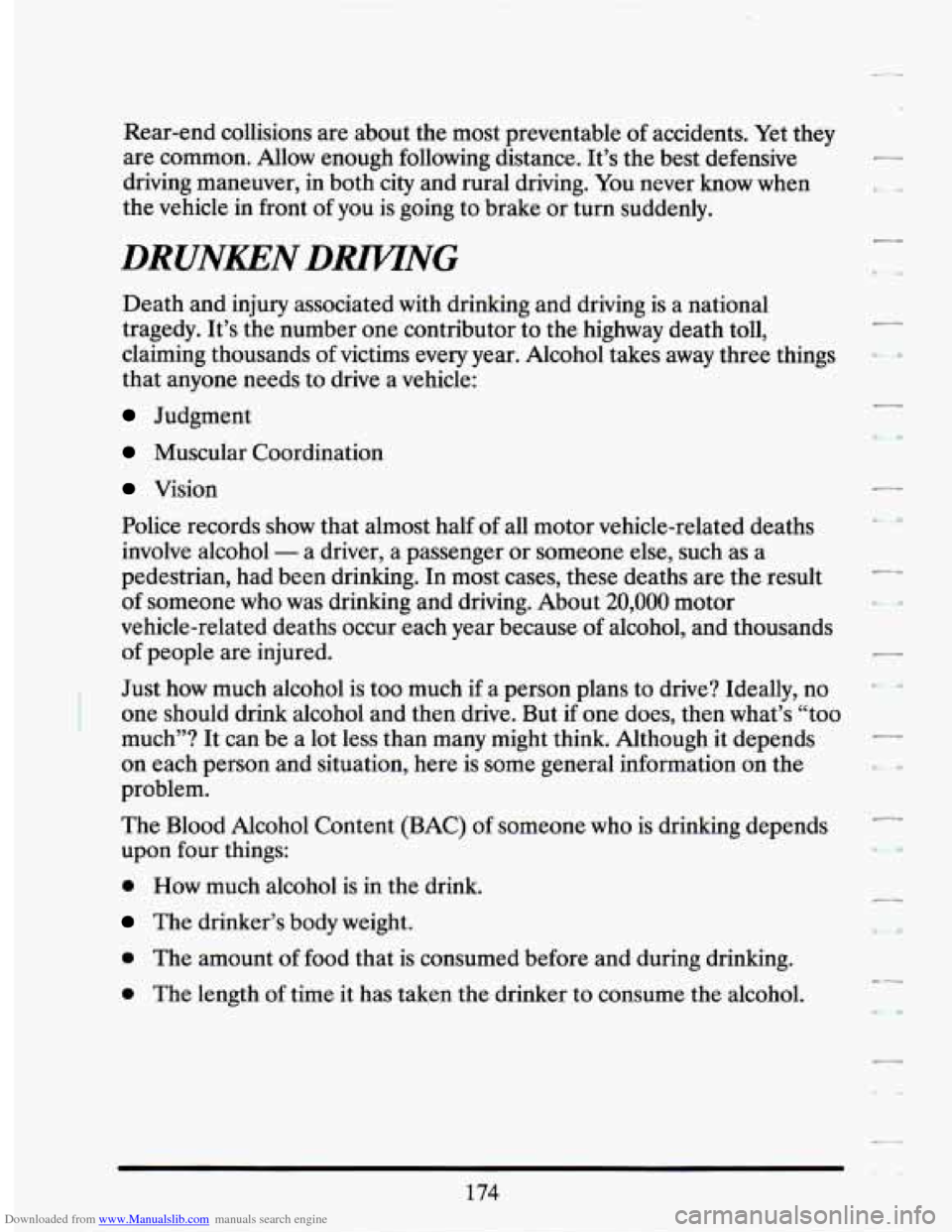
Downloaded from www.Manualslib.com manuals search engine Rear-end collisions are about the most preventable of accidents. Yet they
are common. Allow enough following distance. It’s the best defensive
driving maneuver, in both city and rural driving. You never know when
the vehicle in front
of you is going to brake or turn suddenly.
DRUNIKE2v DRIVTNG
Death and injury associated with drinking and driving is a national
tragedy. It’s the number one contributor to the highway death toll,
claiming thousands
of victims every year. Alcohol takes away three things
that anyone needs to drive a vehicle:
Judgment
Muscular Coordination
Vision
Police records show that almost half
of all motor vehicle-related deaths
involve alcohol
- a driver, a passenger or someone else, such as a
pedestrian, had been drinking. In most cases, these deaths are the result
of someone who was drinking and driving. About 20,000 motor
vehicle-related deaths occur each year because of alcohol, and thousands
of people are injured.
Just how much alcohol is too much if a person plans to drive? Ideally, no
one should drink alcohol and then drive. But if one does, then what’s “too
much’’? It can be a lot less than many might think. Although it depends
on each person and situation, here is some general information on the
problem.
The Blood Alcohol Content (BAC) of someone who is drinking depends
upon four things:
0 How much alcohol is in the drink.
The drinker’s body weight.
0 The amount of food that is consumed before and during drinking.
0 The length of time it has taken the drinker to consume the alcohol.
Page 190 of 399
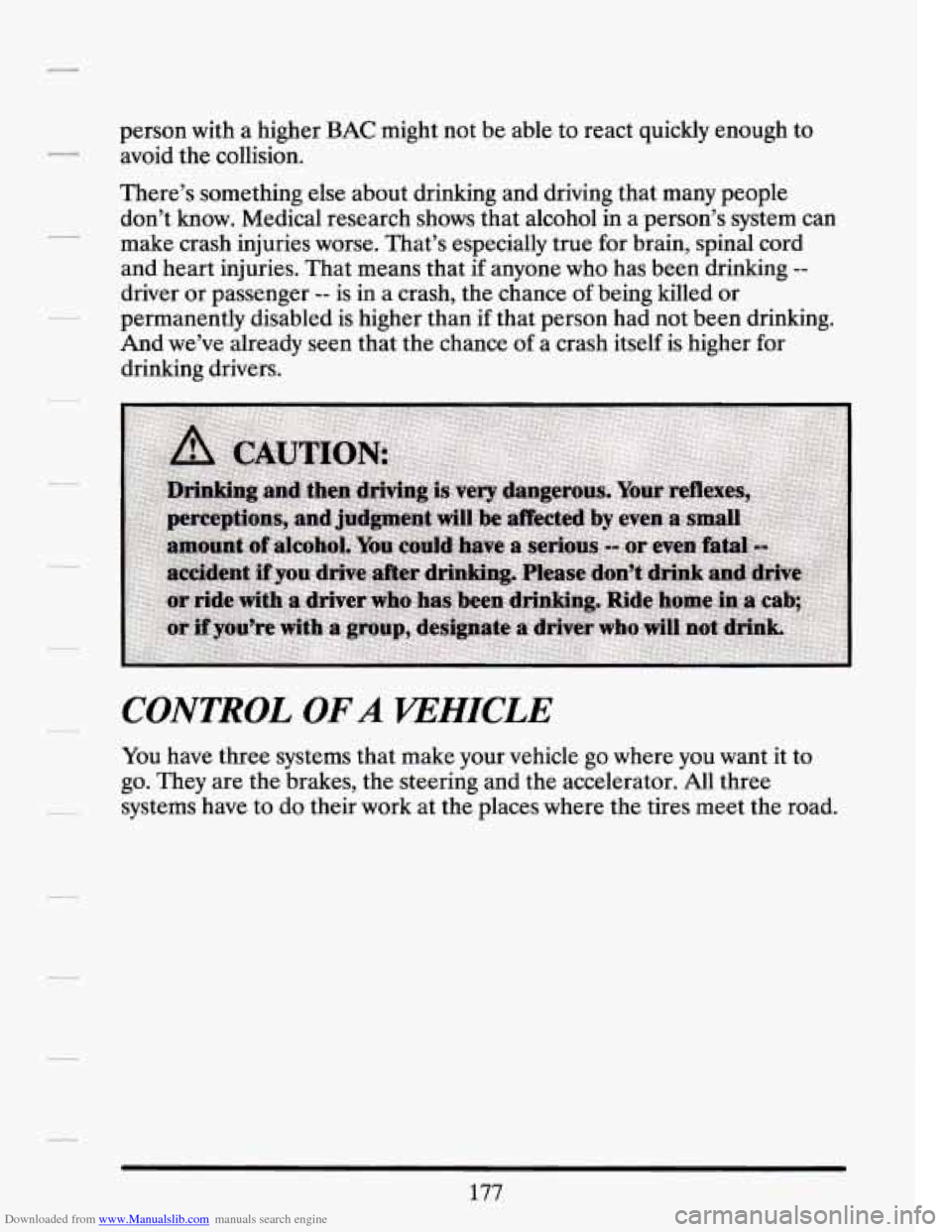
Downloaded from www.Manualslib.com manuals search engine person with a higher BAC might not be able to react quickly enough to
avoid the collision.
There’s something else about drinking and driving that many people
don’t know. Medical research shows that alcohol in a person’s system can
make crash injuries worse. That’s especially true for brain, spinal cord
and heart injuries. That means that if anyone who has been drinking
--
driver or passenger -- is in a crash, the chance of being killed or
permanently disabled is higher than
if that person had not been drinking.
And we’ve already seen that the chance of a crash itself
is higher for
drinking drivers.
CONTROL OF A VEHICLE
You have three systems that make your vehicle go where you want it to
go. They are the brakes, the steering and the accelerator. All three
systems have to
do their work at the places where the tires meet the road.
Page 191 of 399
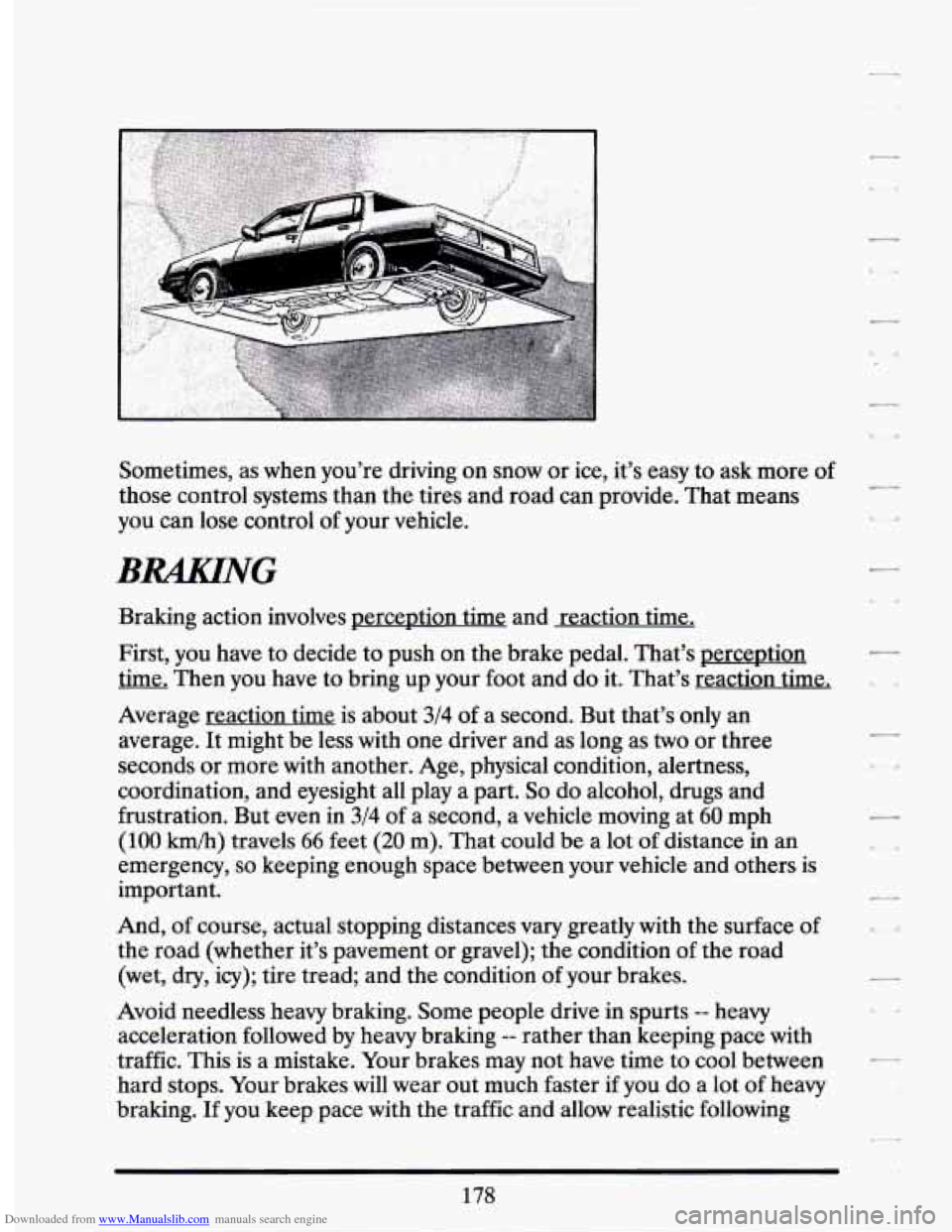
Downloaded from www.Manualslib.com manuals search engine 3
Sometimes, as when you’re driving on snow or ice, it’s easy to ask more of
those control systems than the tires and road can provide. That means
you can lose control of your vehicle.
BRAKIN%
Braking action involves perception time and reaction time.
First, you have to decide to push on the brake pedal. That’s perception
time. Then you have to bring up your foot and do it. That’s reaction time.
Average reaction time is about
3/4 of a second. But that’s only an
average. It might be less with one driver and as long as
two or three
seconds or more with another. Age, physical condition, alertness,
coordination, and eyesight all play a part.
So do alcohol, drugs and
frustration. But even
in 3/4 of a second, a vehicle moving at 60 mph
(100 km/h) travels 66 feet (20 m). That could be a lot of distance in an
emergency,
so keeping enough space between your vehicle and others is
important.
And, of course, actual stopping distances vary greatly with the surface of
the road (whether it’s pavement or gravel); the condition of the road
(wet, dry, icy); tire tread; and the condition
of your brakes.
Avoid needless heavy braking. Some people drive in spurts
-- heavy
acceleration followed by heavy braking
-- rather than keeping pace with
traffic. This is
a mistake. Your brakes may not have time to cool between
hard stops. Your brakes will wear out much faster
if you do a lot of heavy
braking.
If you keep pace with the traffic and allow realistic following
178
7
Page 192 of 399
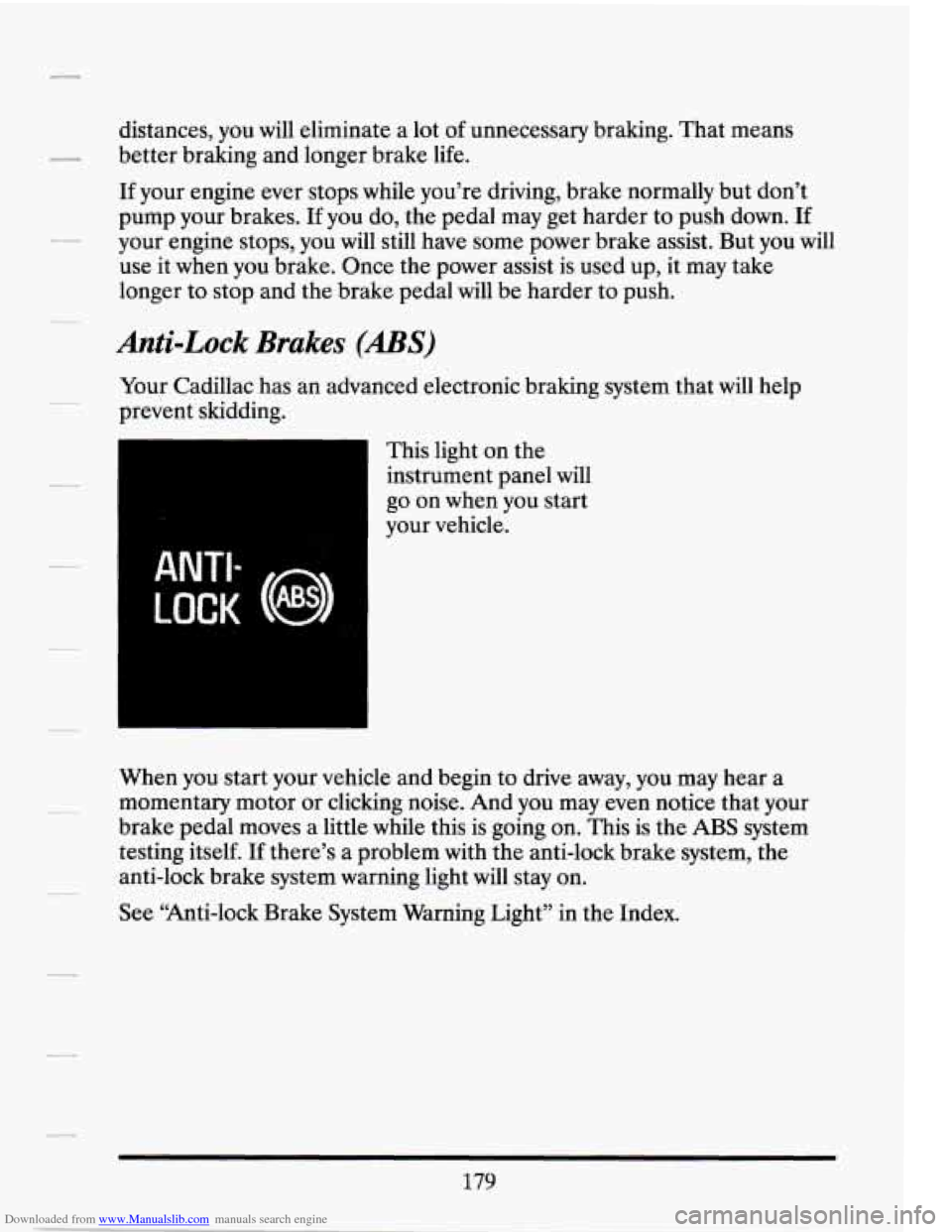
Downloaded from www.Manualslib.com manuals search engine distances, you will eliminate a lot of unnecessary braking. That means
better braking and longer brake life.
If your engine ever stops while you’re driving, brake normally but don’t
pump your brakes.
If you do, the pedal may get harder to push down. If
your engine stops, you will still have some power brake assist. But you will
use it when you brake. Once the power assist is used up, it may take
longer to stop and the brake pedal will be harder to push.
Anti-Lock Brakes (ABS)
Your Cadillac has an advanced electronic braking system that will help
prevent skidding.
This light on the
instrument panel will
go
on when you start
your vehicle.
ANTI-
LOCK (@!
When you start your vehicle and begin to drive away, you may hear a
momentary motor or clicking noise. And you may even notice that your
brake pedal moves a little while this is going on. This is the
ABS system
testing itself.
If there’s a problem with the anti-lock brake system, the
anti-lock brake system warning light will stay on.
See “Anti-lock Brake System Warning Light’’ in the Index.
179